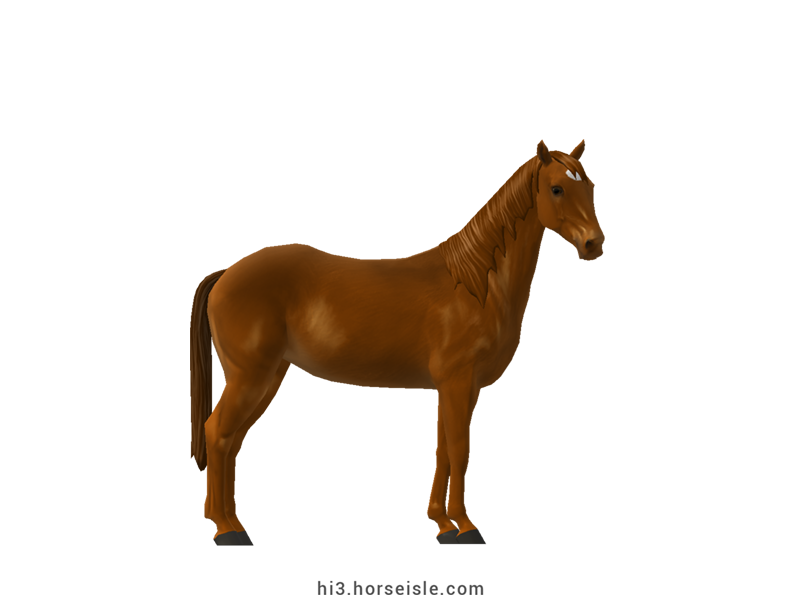Our Massive Real World Equine Reference!
[ INDEX ] Equine Type: Horse Breed: Kisber-Felver (Kisber) [ PREV ] [ NEXT ]
Improving the Thoroughbred:
Back in the 19th century, cavalries were an essential part of every country's army. Hungary was no different, its cavalry consisting mainly of finely-bred Thoroughbred horses. However, their temperamental and flighty personality, together with the costs of importation of new Thoroughbreds when needed, posed a problem.
In 1853, Franz Joseph I of Austria, Hungary's king at the time, ordered the establishment of a new military state stud at the already existing estate on Kisber. There, Thoroughbred stallions were crossed with mares of Hungarian breeds as well as with mares of a variety of other breeds such as Arabian and Mecklenburg.
After several years of selective breeding, a new type of horse was born. One who was larger and calmer than the Thoroughbred, but had its athleticism and endurance. It was known as 'Felver', meaning 'Halfbred'.
The birth of the Kisber-Felver:
By the beginning of the 20th century, Kisber horses were famous for their performance as riding horses. However, following World War I, the need for light farm horses prompted Kisber breeders to breed their horses to be more heavily muscled.
In addition, during the 1930s, Trakehner stallions were imported and crossed with Kisber mares to improve the Kisber's athleticism while maintaining its overall massiveness. This gave birth to the Kisber-Felver which we know today.
From a popular breed to the brink of extinction:
World War II brought great turmoil to Hungary and didn't spare its horses, including the Kisber-Felvers. Many horses were lost during the war, and by the end of it the remaining Kisber-Felver stock was splitted. Some horses stayed in Hungary, some were transported to Germany, and some were shipped to the United States.
In addition to being threatened by low numbers, excessive crossbreeding with other sport breeds during the 1960s and 1970s put the purity of the Kisber-Felver under threat.
It was subsequently saved thanks to the work of two organizations. First, the Hungarian Horse Association which was founded in 1966 in the USA, worked to preserve the line of Kisber-Felver horses in the USA. Second, the [Hungarian] National Association of Kisber-Felver Breeders (as translated to English), which was established in Hungary in 1989 and preserved the Kisber-Felver in Hungary.
The Kisber-Felver today:
Today, the Kisber-Felver still exists in small numbers in Hungary and the USA. It is known for its jumping ability and endurance which make it good for cross-country and three-day eventing.
Breeding:
Generally speaking, Kisber-Felvers are allowed to be crossed with Thoroughbreds, Arabians, and Shagya-Arabians. However, one parent must be a Kisber-Felver in order for the foal to be registered as a Kisber-Felver. Therefore, in Horse Isle, Kisber-Felvers have a closed studbook and no crossbreeding is allowed.
Conformation:
In general, the conformation of the Kisber-Felver can be described as a larger, heavier version of the English Thoroughbred (not American Thoroughbred).
Kisber-Felvers have a light, thin head with large eyes, small ears, and a straight profile. The neck is long and of high-set with medium arching. The withers are long and the back is far deeper than usually seen in sport warmbloods. The croup is sloped and the hindquarters are slender.
Performance metrics:
The following are the: range, average, (SD), and MOE of performance metrics of ordered Kisber-Felvers in Horse Isle (not bred ones). In rare cases,
Speed: 16.3-17.8, 17.1 (0.3), 0.07.
Sprint: 41-54, 48 (3), 0.59.
Accel: 0.71-0.90, 0.80 (0.04), 0.01.
Decel: 0.78-0.93, 0.86 (0.03), 0.01.
Jump: 5.22-5.44, 5.33 (0.05), 0.01.
Pull: 1.92-2.64, 2.27 (0.16), 0.03.
Turning: 40.79-55.36, 47.55 (2.89), 0.57.
Reverse: 2.2-2.8, 2.5 (0.1), 0.03.
Stamina: 46.19-51.32, 48.66 (1.2), 0.24.
Reaction: 0.79-0.90, 0.85 (0.02), 0.00.
Coats & Height:
Colors: usually bay, brown, or chestnut, but more rarely black or grey.
Additionals: flaxen, sooty, dark mane & tail. Pinto markings as undesirable, and so horses will be penalized for having stockings or wide blazes.
Height: 15.1hh to 17hh
[ INDEX ] [ PREV ] [ NEXT ]
















